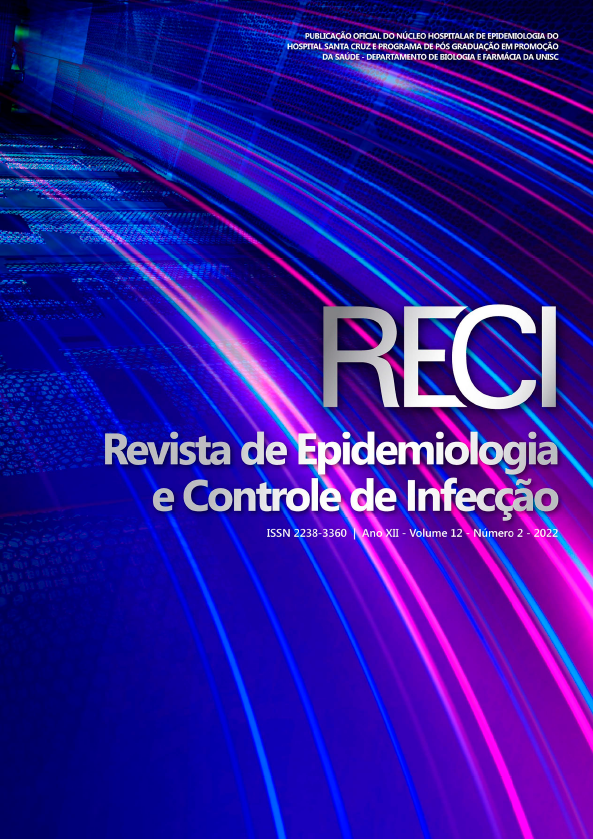An epidemiologic analysis of Candida spp. urinary infections in intensive care unit
DOI:
https://doi.org/10.17058/reci.v12i2.17026Abstract
Background and objectives: The finding of Candida species in urine is an usual finding and is called candiduria. There is an increase in the frequency of urinary tract infections (UTI) caused by Candida especially in critically ill patients. This study aimed to determine the epidemiological, clinical, and mycological characteristics of Candida urinary infections in intensive care unit (ICU) and antifungal susceptibilities. Methods: Urine cultures of 394 ICU patients with clinical suspicion of UTI were evaluated. After 24-48 hours of incubation, colonies appeared to grow as yeast, were morphologically examined by Gram staining. Candida strains that grew 104 ≥ CFU/mL in urine cultures were accepted as candiduria. The susceptibilities of the Candida strains to amphotericin B, itraconazole, fluconazole, voriconazole, flucytosine, and caspofungin were investigated with broth microdilution method. Results: The distribution of the isolated 100 urinary Candida strains were as, 54 Candida albicans, 34 C. glabrata, 7 C. tropicalis, 2 C. kefyr, 2 C. lusitaniae, and 1 as C. parapsilosis. Among 100 Candida species isolated in our study susceptibility rates of amphotericin B, flucytosine, caspofungin, fluconazole, itraconazole, and voriconazole were 100%, 100%, 91%, 23%, 13%, 25.8%, respectively. Conclusion: Accurate identification of Candida spp., as well as the investigating the antifungal susceptibility, will be beneficial in terms of the effectiveness of the treatment and the prevention of resistance development.
Downloads
References
Gajdács M, Dóczi I, Ábrók M, et al. Epidemiology of candiduria and Candida urinary tract infections in inpatients and outpatients: results from a 10-year retrospective survey. Cent European J Urol. 2019;72(2):209-214. https://doi.org/10.5173/ceju.2019.1909
Hollenbach E. To treat or not to treat--critically ill patients with candiduria. Mycoses. 2008;51(2):12-24. https://doi.org/10.1111/j.1439-0507.2008.01570.x
Kauffman CA, Vazquez JA, Sobel JD, et al. Prospective multicenter surveillance study of funguria in hospitalized patients. The National Institute for Allergy and Infectious Diseases (NIAID) Mycoses Study Group. Clin Infect Dis. 2000;30(1):14-18. https://doi.org/10.1086/313583
Bougnoux ME, Kac G, Aegerter P, et al. Candidemia and candiduria in critically ill patients admitted to intensive care units in France: incidence, molecular diversity, management and outcome. Intensive Care Med. 2008;34(2):292-299. https://doi.org/10.1007/s00134-007-0865-y
Fisher JF, Sobel JD, Kauffman CA, et al. Candida urinary tract infections--treatment. Clin Infect Dis. 2011;52(Suppl 6):457-66. https://doi.org/10.1093/cid/cir112
Fisher JF. Candida urinary tract infections--epidemiology, pathogenesis, diagnosis, and treatment: executive summary. Clin Infect Dis. 2011;52(Suppl 6):429-32. https://doi.org/10.1093/cid/cir108
Kauffman CA. Candiduria. Clin Infect Dis. 2005;41:371–6. https://doi.org/10.1086/430918
Alvarez-Lerma F, Nolla-Salas J, León C, et al. Candiduria in critically ill patients admitted to intensive care medical units. Intensive Care Med. 2003;29(7):1069-1076. https://doi.org/10.1007/s00134-003-1807-y
Sobel JD, Fisher JF, Kauffman CA, et al. Candida urinary tract infections--epidemiology. Clin Infect Dis. 2011;52(Suppl 6):433-6. https://doi.org/10.1093/cid/cir109
Alfouzan WA. Epidemiological study on species identification and susceptibility profile of Candida in urine. Fungal Genom Biol. 2015;5:124. https://doi.org/10.4172/2165-8056.1000124
Achkar JM, Fries BC. Candida infections of the genitourinary tract. Clin Microbiol Rev. 2010;23(2):253-273. https://doi.org/10.1128/CMR.00076-09
Jamil S, Jamil N, Saad U, et al. Frequency of Candida albicans in Patients with Funguria. J Coll Physicians Surg Pak. 2016;26(2):113-116.
Sakamoto Y, Kawabe K, Suzuki T, et al. Species Distribution of Candidemia and Their Susceptibility in a Single Japanese University Hospital: Prior Micafungin Use Affects the Appearance of Candida parapsilosis and Elevation of Micafungin MICs in Non-parapsilosis Candida Species. J Fungi (Basel). 2021;7(8):596. https://doi.org/10.3390/jof7080596
He Z, Huo X, Lei D, et al. Management of candiduria in hospitalized patients: a single-center study on the implementation of IDSA guidelines and factors affecting clinical decisions. Eur J Clin Microbiol Infect Dis. 2021;40(1):59-65. https://doi.org/10.1007/s10096-020-03999-1
Denis B, Chopin D, Piron P, et al. Candiduria in kidney transplant recipients: Is antifungal therapy useful?. Mycoses. 2018;61(5):298-304. https://doi.org/10.1111/myc.12740
Sobel JD, Kauffman CA, McKinsey D. Candiduria: a randomized, double-blind study of treatment with fluconazole and placebo. The National Institute of Allergy and Infectious Diseases (NIAID) Mycoses Study Group. Clin Infect Dis. 2000;30(1):19-24. https://doi.org/10.1086/313580
Clinical and Laboratory Standards Institute (CLSI). Reference method for broth dilution antifungal susceptibility testing of yeasts; approved Standard-third edition. CLSI document M27-A3. Clinical and Laboratory Standards Institute, Wayne, Pennsylvania 2008.
Clinical and Laboratory Standards Institute (CLSI). Reference method for broth dilution antifungal susceptibility testing of yeasts; third informational supplement CLSI document M27-S3. Clinical and Laboratory Standards Institute, Wayne, Pennsylvania 2008.
Clinical and Laboratory Standards Institute (CLSI). Reference method for broth dilution antifungal susceptibility testing of yeasts; fourth informational supplement CLSI document M27-S4. Clinical and Laboratory Standards Institute, Wayne, Pennsylvania 2012.
Wang K, Hsueh K, Kronen R, et al. Creation and assessment of a clinical predictive model for candidaemia in patients with candiduria. Mycoses. 2019;62(7):554-561. https://doi.org/10.1111/myc.12917
García-Agudo L, Rodríguez-Iglesias M, Carranza-González R. Approach of clinicians to candiduria and related outcome in the elderly. J Mycol Med. 2018;28(3):428-432. https://doi.org/10.1016/j.mycmed.2018.05.011
He Z, Su C, Bi Y, et al. Evaluation of a Novel Laboratory Candiduria Screening Protocol in the Intensive Care Unit. Infect Drug Resist. 2021;14:489-496. https://doi.org/10.2147/IDR.S289885
He Z, Liu Y, Wang T, et al. Candiduria in hospitalized patients: an investigation with the Sysmex UF-1000i urine analyzer. PeerJ. 2019;7:e6935. https://doi.org/10.7717/peerj.6935
Aghili SR, Abastabar M, Soleimani A, Haghani I, Azizi S. High prevalence of asymptomatic nosocomial candiduria due to Candida glabrata among hospitalized patients with heart failure: a matter of some concern?. Curr Med Mycol. 2020;6(4):1-8. https://doi.org/10.18502/cmm.6.4.5327
Downloads
Published
How to Cite
Issue
Section
License
Copyright (c) 2022 Fahriye Ekşi, Ban Ali Hassan, Berna Kaya Uğur, Hamit Yıldız, Mehmet Erinmez, Süleyman Ganidağlı

This work is licensed under a Creative Commons Attribution 4.0 International License.
The author must state that the paper is original (has not been published previously), not infringing any copyright or other ownership right involving third parties. Once the paper is submitted, the Journal reserves the right to make normative changes, such as spelling and grammar, in order to maintain the language standard, but respecting the author’s style. The published papers become ownership of RECI, considering that all the opinions expressed by the authors are their responsibility. Because we are an open access journal, we allow free use of articles in educational and scientific applications provided the source is cited under the Creative Commons CC-BY license.


